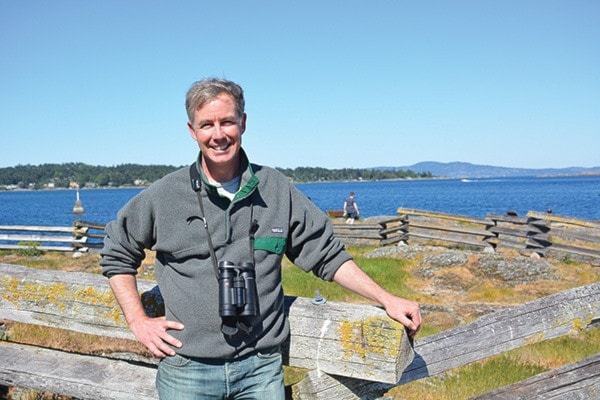If you go into the woods today – or onto the beach – a new app for your phone or iPad will add to the experience.
From seaweeds and sea stars to wolves and eagles, a new University of Victoria-developed digital field guide provides experts and amateurs with a tool to identify more than 700 species in the Great Bear Rainforest to help deepen appreciation of B.C.’s coastal biodiversity.
A collaborative project developed by community ecologist and conservation biologist Brian Starzomski, with UVic graduate student Chanda Brietzke and UVic alumna Kelly Fretwell, with support from the Hakai Institute and its researchers, created the free guide for phone, computer and tablet. “Central Coast Biodiversity” has a current inventory of 210 plants, 80 birds, 120 seaweeds, 190 marine invertebrates and 20 mammals and reptiles, far more than most conventional field guides, with more being added.
“Whether on a beach or in the forest, anyone can use the app and hopefully identify the species they have found,” Starzomski says. “B.C. has the most species of any province in Canada and coastal B.C. in particular is amazing in this regard.”
A professor in UVic’s School of Environmental Studies, Starzomski is the Ian McTaggart Cowan Professor of Biodiversity Conservation and Ecological Restoration and also leads the Starzomski Lab at UVic. The app emerged from courses he taught in the Central Coast, where assignments required students to each document 50 species. With so many species documented, sharing it seemed the next step.
“It’s partly to teach people about the natural environment around them,” Starzomski says.
While the focus is on the Central Coast at this point, “many of the species are found from Alaska all the way to northern California,” says Starzomski, who was recently birdwatching near Oak Bay’s Victoria Golf Course and seeing many species included in the app.
“This covers all kinds of different species,” Starzomski says, noting the team has pulled in experts in different specialties – such as seaweeds – where needed. “We hope people will use it just because they love the natural environment as much as we do.”
Students, researchers and the public can interact with the app to find important and fascinating information. It also features a growing list of species at risk, including some like sea otters and humpback whales that have been doing well on the coast and others, like abalone, that aren’t doing so well, Starzomski says.
“We talk about ‘Beautiful B.C.,’ but B.C. has half of all the species that are found in Canada,” Starzomski says. “This is the most biodiverse, with the most different kinds of habitats and all have these incredibly wild places.”
Foggy Cove, a tiny rocky beach on Calvert Island, is home to some 250 species. In contrast, our own Willows Beach, despite its much larger size, has just a fraction of those species, because of factors such as increased foot traffic, water run-off and other urban realities.
The app is expanding and plans are in the works to include species in the Greater Victoria area, Quadra Island and Bamfield.
“We’re expanding every day and putting up several new species a week,” Starzomski says, noting response has been excellent, generating up to 20,000 “hits” a day online and hundreds of downloads.
Users will soon be able to use the app offline as well, perfect for treks and paddles outside urban areas.
Starzomski also welcomes nature enthusiasts from throughout the community to send along their photos to be added to the collection. Contributors should indicate when and where the photo was taken, and their name for photo credit in the app.
Some species, like loons, for example, will look different between summer and winter, so it’s important to have several identifiers, he says. Other species he’d like more photos of include peregrine falcon, osprey, northern goshawk and Cooper’s hawk, in addition to gulls and fish species.
“We have not been able to get a really good picture of a Chinook salmon,” he says.
Download the new app on the Apple App Store or for Android on Google Play.
